Ecology, Ornithology and Nature
Establishing a detailed ecological record of the site enables us to develop the design in a manner that avoids or minimises adverse effects on sensitive habitats and protected species.
We have…
- Undertaken a series of desk-based studies and consultations with organisations including Scottish Natural Heritage (SNH), RSPB, Scottish Badgers and Local Fisheries Boards to identify known species and habitats.
- Undertaken baseline ecological surveys on site for protected species and habitats.
- Undertaken flight activity surveys in 2019 and 2020 as well as breeding bird, breeding raptor, Black Grouse and Nightjar surveys.
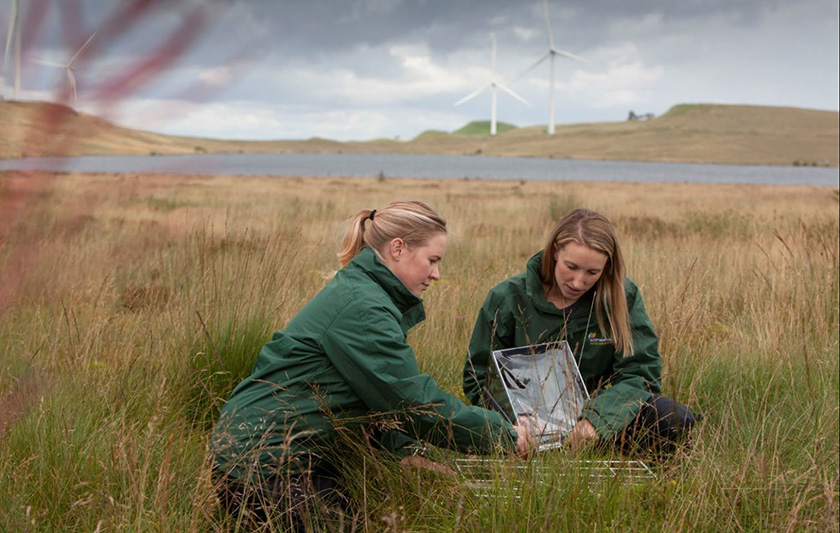
Above: SPR’s inhouse ecology team conducting conservation fieldwork
We found…
The Forest of Ae is not a statutorily designated nature conservation site and consists primarily of commercial forestry. This provides a suitable habitat for a number of species under varying levels of protection.
The surveys found evidence of protected species including bats, otter, water vole, badger and pine marten. Bird surveys to date have shown that goshawk and pink-footed geese are the key species of conservation interest present.
Some sensitive habitats were also identified..
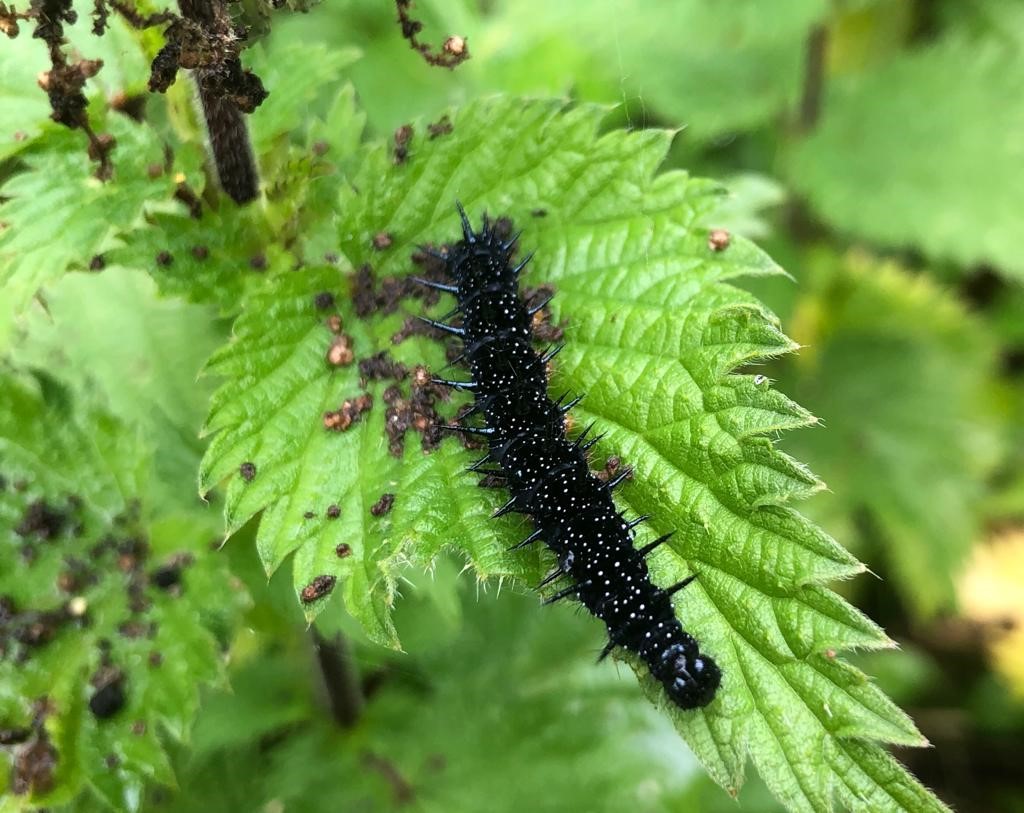
Above: Peakcock butterfly caterpillar on common nettles identified at the Site
Protecting Species
SPR will seek to mitigate impacts on ecology and ornithology in a variety of ways:
- Avoiding construction during the bird breeding season where possible, or where not possible undertaking surveys to identify and protect any nesting birds.
- Avoiding areas of blanket bog identified during the Phase One/NVC vegetation surveys.
- Pollution control measures to prevent silt or dusts entering watercourses.
- Designing any new or upgraded watercourse crossings to maintain safe passage of fish.
Any potential adverse effects for any species will be mitigated to meet the applicable standards and species-specific mitigation plans will be created for each as required.
Our understanding of the ground conditions and surface water network has informed the site design. This minimises the risk of groundwater, surface water and areas of peat being adversely affected. Our technical specialists work closely with one another to ensure that the potential effects of the proposed Development on hydrology and related habitats and species are considered holistically. This is particularly important for Ground Water Dependent Terrestrial Ecosystems, for example.
We have…
Avoided watercourses on the site, as far as possible. We have also investigated peat depths across the site, identified the location of private water supplies and the potential for flooding from the watercourses.
We found…
Our technical teams have identified the key hydrological components in and around the proposed Development. This allows us to understand how rainfall and surface water run off infiltrates into soils and peat and discharges into watercourses and drainage channels.
This information has also allowed us to assess whether any private water supplies are potentially at risk of being affected by construction works.
The peat surveys revealed that there are varying depths of peat across the site, with some localised areas of deeper peat.
Protecting watercourses during construction
During the construction phase, pollution of water entering watercourses will be prevented through a range of measures including the use of silt traps, settlement ponds and cut off drains, as well as a surface water monitoring programme. This is to ensure that water quality of private water supplies and watercourses such as Water of Ae, Glenkiln Burn and Kirkland Burn are protected and maintained.
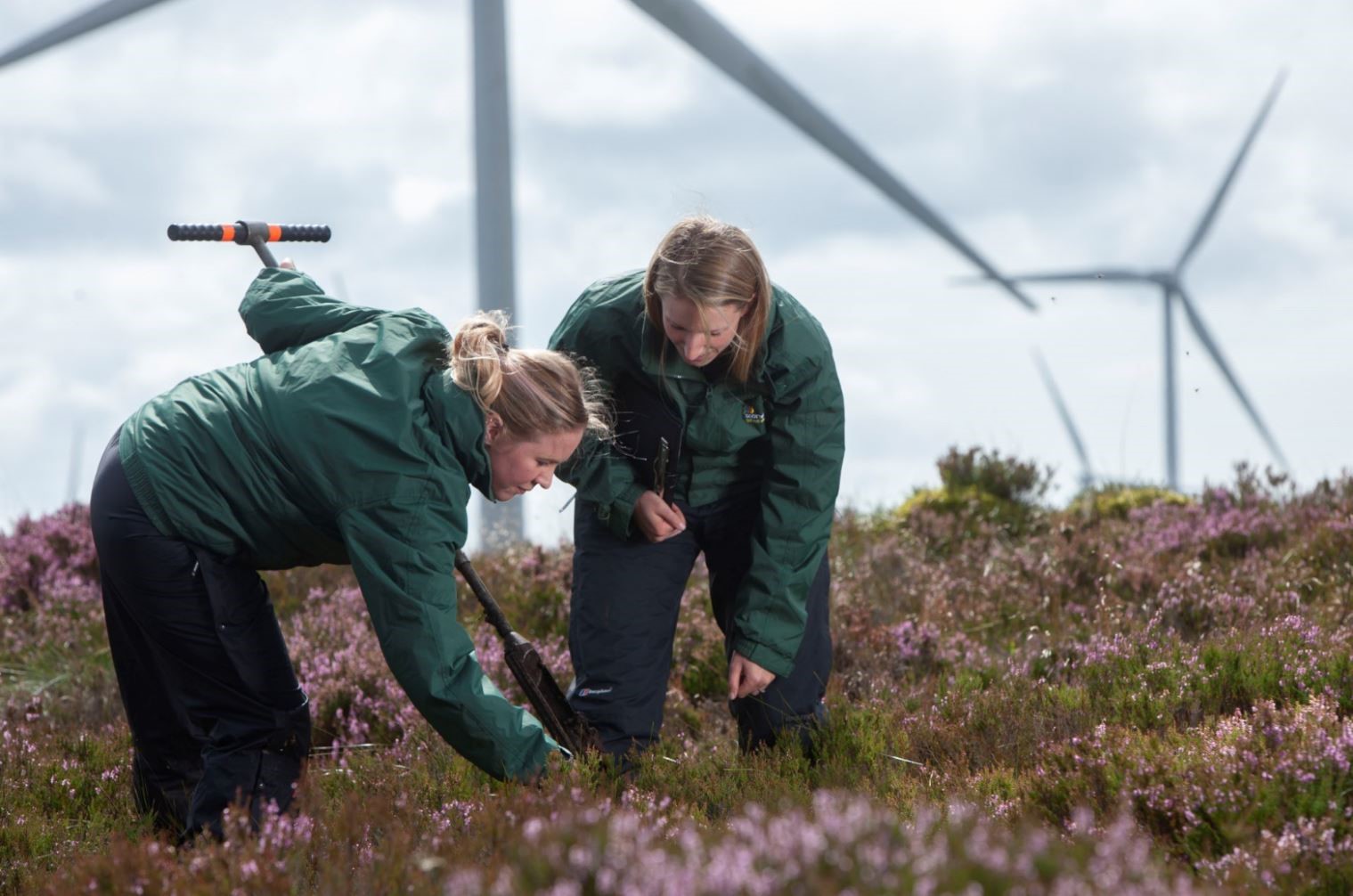
Above: SPR’s inhouse Ecology Team conducting onsite fieldwork
Archaeology relates primarily to the buried remains and artefacts that could be affected by the construction works related to the building of the proposed Development.
Cultural heritage also relates to other sites, features and locations in the wider landscape which have the potential to have their setting affected by the proposed Development.
We have…
Undertaken a desk-based study to identify all known assets registered with national and local archaeological bodies, as well as a site walkover to identify any previously unknown assets.
We found…
No designated heritage assets (World Heritage Sites, Inventoried Battlefields, or Inventoried Garden and Designed Landscapes) are found within the proposed Development boundary.
Wallaces House Fort, a Scheduled Monument, is located adjacent to the boundary along the access route from the A701. Garvald Church and Church Yard, a listed building, is located close to the site access where it meets the A701.
No new archaeological assets were identified during the walkover survey. However, six further assets were identified during map regression; these range from sheep folds, dry stone walls to enclosures.
Protecting assets during construction.
Archaeological mitigation is proposed during construction in order to identify the presence of, record and, where appropriate, protect any archaeological remains that are encountered.
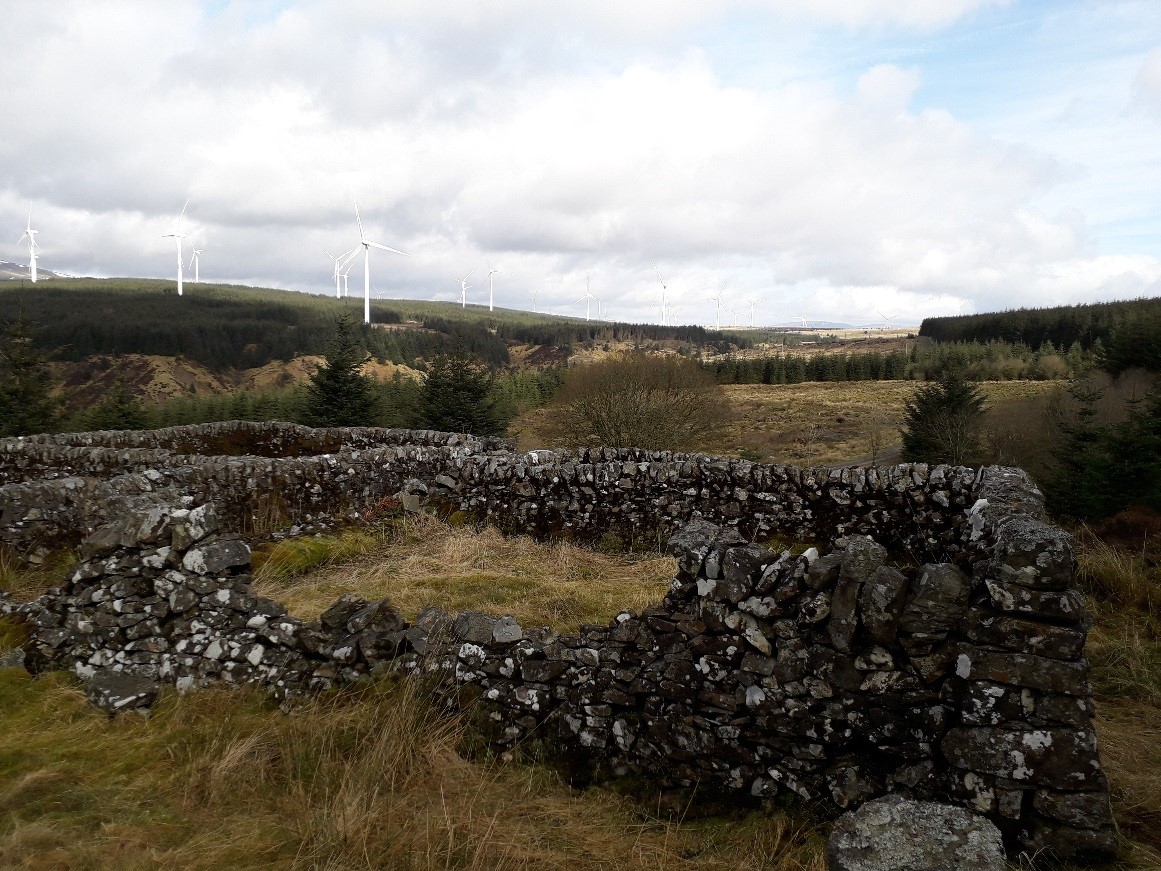
Above: Sheep ree identified during walkover survey and from map regression, with the operational Harestanes windfarm visible in the background
We have…
SPR is undertaking a detailed study of the noise environment. This includes undertaking noise monitoring at four representative residential properties around the site as well as using existing background noise data from nearby windfarms. Noise modelling is being undertaken to predict likely levels of wind turbine noise. This will include a cumulative assessment which considers the noise generation of the proposed Development in combination with other consented and operational wind energy developments in the area. Existing and predicted noise levels will be considered against the current guidance to determine if impacts will be significant.
We found…
The potential impact of noise from the proposed Development has been continuously assessed during the design process, and the layout refined through the appropriate siting of turbines in relation to identified residential properties.
Protecting residents during construction.
Noise from construction activities will be controlled through the use of a Construction Environmental Management Plan.
We have…
SPR and our technical consultants have assessed the potential impacts on access, traffic and transport. This considers the potential effects of the proposed Development on the transport network, primarily in relation to construction vehicles.
This study also considered the delivery route of the main turbine components to the Site from the nearby ports, and the potential for environmental effects of vehicles using the public road network.
We found…
It is proposed that turbine components are delivered to Glasgow King George V Dock. They would then be transported to the site principally via the M8, M74, A75 and then A701 to the existing site entrance. Various transport routes comprising the M74, A75, A76 and A701 for general construction traffic to the site are being considered in the assessment.
Delivery of the larger turbine components to Site during construction will require careful management and scheduling and all heavy good vehicles and abnormal load traffic will use the agreed access route. Once operational, impacts on traffic and transport from the proposed Development is predicted to be minimal.
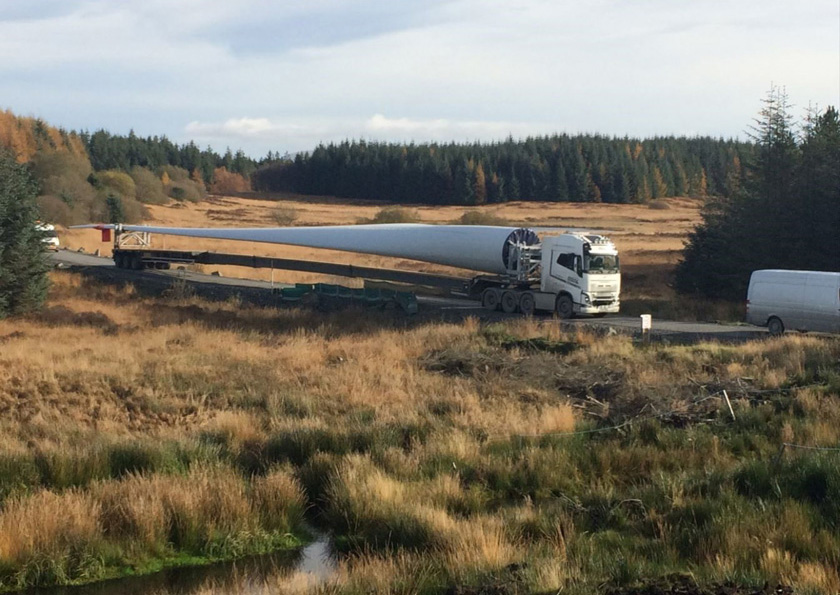
Above: Blade Image shows delivery vehicle with 57 m blade, Harestanes South blades will be up to 75 m in length
Protecting road users and residents
In order to minimise the impact on local residents and other road users, the existing site access and forestry tracks will be used and upgraded where required. Furthermore, a Construction Environmental Management Plan and a Traffic Management Plan will be produced. The following practices will be used:
- Construction vehicles to use approved access routes and adhere to any necessary restrictions.
- Erection of appropriate temporary signage in the vicinity of the site warning of construction traffic and warning other users of abnormal load turbine movements.
- Abnormal loads will be escorted from the port of entry with timings agreed with the road authorities and police as appropriate.
- Ground preparation, including protection of services.
- Arrangements for road maintenance, wheel washing and road sweeping where necessary.
An assessment of the potential socio-economic, tourism and recreation impacts of the proposed Development is being undertaken as part of the Environmental Impact Assessment Report.
We have…
Reviewed the existing baseline conditions, including the identification of local recreational groups, tourist attractions and business/employment conditions and SPR’s community benefit schemes in the region; and will be undertaking an assessment of the potential effects of the proposed Development against these baseline conditions.
We found…
The area features one of the 7Stanes mountain bike trails to the west of the site as well as the Romans and Reivers long distance walking path which runs north-south through the site.
The construction and operation of the proposed Development has the potential to benefit the local and regional economies through:
- Direct construction and operation employment opportunities.
- Indirect employment further down the supply chain for those companies providing services to the contractors during the construction and operation phases of the development.
What we will do…
- We will seek to use local labour where possible to maximise the benefits to the local economy.
- Whilst there may be some restrictions on access to the site during construction for health and safety reasons, we are committed to making provision for access during the operation of the proposed Development.
- We will continue to consult with recreational groups to identify and respond to any opportunities and areas of concern.
- We will seek to engage with local schools and educational establishments to share knowledge and build relationships.
- We will work with the community to develop the Community Benefit and investment opportunities in a way that responds to their needs.
Wind turbines have the potential to cause an impact on military and civil aviation operations, primarily through effects on radar and the air traffic service provided using impacted radars.
We have…
The project team has consulted with relevant stakeholders (Ministry of Defence (MoD), Civil Aviation Authority and NATS) and has also undertaken an assessment in relation to aviation activity in the area.
We found…
Our aviation assessment suggests that some of the turbines may be visible to MoD and NATS radar, although whether there is a detriment impact on the air traffic service provided has not been determined. Should there be a demonstrated detrimental impact on either MoD or NATS air traffic service, we will explore appropriate mitigation options with the relevant aviation stakeholder so as to ensure that airspace remains safe.
We have…
Undertaken consultation with relevant bodies to establish the presence of utilities and telecommunication links across the site.
We found…
There are two telecommunication links and a mast within the site, however the proposed Development has been designed to avoid impacts to these telecommunications links.
There are no overhead electricity lines within the site.
The current land use of the site is as a commercial forest.
Construction of the proposed Development would retain as much forestry as possible by using a ‘key holed’ approach. A Development Forest Design Plan will be produced as part of the EIA process to show which areas of woodland would be felled to facilitate the proposed Development and how the forest will be re-stocked during the life of the proposed Development.
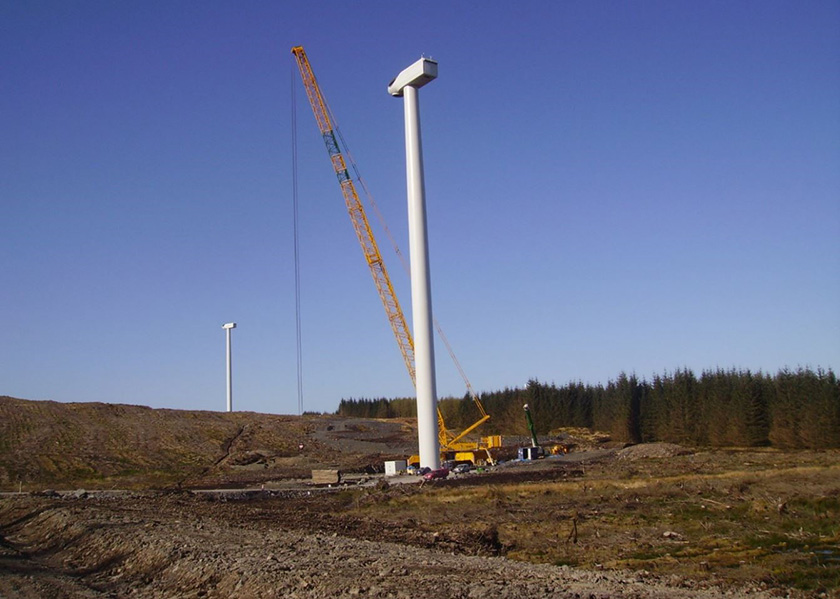
SPR’s Kilgallioch Windfarm during construction. Turbines in image are 180 metres tall.
The proposed turbine height at Harestanes South will be up to 200 metres to blade tip.
Embedded Design
A number of design mitigations have been embedded into the site design as a result of the EIA surveys. These include the following:
- Limit the number of proposed turbines seen directly against the operational Harestanes windfarm turbines.
- Aim to achieve a more coherent single cluster of turbines, avoiding splitting the layout into separate groups and subsequently extended horizontal extent.
- Avoid locating turbines near to the 7Stanes mountain biking trails.
- We have sought to avoid areas of deep peat as far as practicable.
- Some more sensitive vegetation habitats have been identified resulting in the relocation of some turbines.
- Impacts on watercourses have been minimised by retaining a buffer of 50m from any of the turbines, crane pad, hardstanding’s, temporary compounds or the substation in the site design.
- The road layout uses as much existing forestry road as possible, reducing the amount of new track and water crossings required for the construction of the proposed Development.
- The site design avoids any known designated assets through applying a buffer.
- Appropriate stand-off distances have been integrated into the site design to ensure there is no impact on the telecommunications links.
In addition, SPR will ensure there are no detrimental effects for residents on their telecommunication services.
Go back to the main pageGo to the next page